The main stage of training in a driving school is a driving training drive. With memorization of the rules traffic almost no one has any problems, but with the passing of practical skills in driving a vehicle, many earn their own penalty points. What are the requirements for training riding currently used, who can provide training and what restrictions are applied?
Driving instruction
Driving a car is fully regulated by the legislative norms specified in the SDA of the Russian Federation (topic 21).
According to them, the student at the time of study should be 16 years old. This applies, in particular, to two-wheeled vehicles. Passing the driving test is allowed from the age of 18. Exception - transport subcategory A1.
Before the study visit, the student is required to thoroughly know the traffic rules and use them in practice. In the first lesson, learning the techniques of starting, stopping the vehicle, performing maneuvers, turns, and reversing takes place. All this happens at the racetrack without car traffic.
Only after the future driver will be able to use the vehicle thoroughly, is it allowed to drive around the city.
City Driving
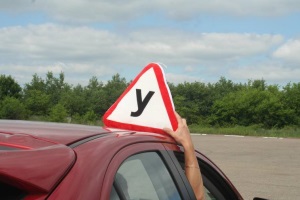 In urban areas, practical driving skills training is allowed only on a specially equipped car with the “U” sign (front and rear or only on the roof) and redundant clutch pedals, brakes (on cars with automatic transmission - only with a brake). In addition, a rear-view mirror is installed for the instructor to fully control the situation on the road.
In urban areas, practical driving skills training is allowed only on a specially equipped car with the “U” sign (front and rear or only on the roof) and redundant clutch pedals, brakes (on cars with automatic transmission - only with a brake). In addition, a rear-view mirror is installed for the instructor to fully control the situation on the road.
Motorcycling is not allowed.. Training and passing the exam takes place at the training site (circuit) in the order established by the rules of the road.
The movement speed during training is regulated by the applicable traffic regulations without any restrictions. In the early stages, trainers are advised not to exceed the speed limit of 40 kilometers per hour, but this is not a mandatory measure.
Training riding is carried out only during daylight hours in conditions of normal visibility. When the car moves inside the passengers, except for the instructor, it cannot be present. The vehicle itself must necessarily be in good technical condition.
The student is required to have a document with him confirming his actual age, while the instructor, at the request of the traffic police inspector, must provide a document giving the right to conduct the educational process and a driver’s license of the corresponding category (subcategory).
Where study riding is prohibited
 The route for a training ride is determined in advance in cooperation with the traffic police and local authorities.
The route for a training ride is determined in advance in cooperation with the traffic police and local authorities.
The list of roads on which driving is prohibited:
- in the residential area (as well as in the courtyard), marked with the sign 5.21;
- on roads marked with the “road for cars” sign, marked with the sign 5.3;
- Many people ask the question: “Is driving on the highway permitted?” Answer: "Educational driving on the motorway is prohibited, indicated by 5.1."
At the discretion of the traffic police and authorities, a local ban on the use of certain roads within the city may be introduced.
Training riding in the dark is prohibited on all roads, including the circuit. The main task of the student is to learn to adequately assess the traffic situation and make appropriate decisions, observing the applicable traffic rules. Emergency management is not a topic of driving instruction.
When training driving in the city, it is recommended to choose roads with minimal traffic and good road surface. It is allowed to use the vehicle with both a manual and an automatic transmission, including at the exam.
Access to the training drive on the road is not provided. The final decision is made by the instructor based on a vision of the student’s practical driving skills. And he is responsible for all the violations that he will allow in the learning process.
Acceptable duration of study driving practice is not regulated. If necessary, the future driver can perform as many trips as necessary, if he needs it to improve his skills.
Video: Traffic driving
Now almost every person over the age of 18 can get a driver’s license. To do this, you only need to choose a driving school, attend classes regularly and pass exams within 3 months. Theoretical preparation, as well as instructional driving (on-site and directly in urban areas) are required. You can get both the right to drive passenger vehicles and trucks. Tightened rules for taking the exam do not always give the opportunity to pass the first time, because a couple of mistakes can already lead a person to the word "retake."
Requirements for the training vehicle
The necessary equipment is provided by special organizations that sell and service this type of equipment. The installation rests on the shoulders of the masters of driving schools or employees of the mentioned companies. The sign is established by each driving school individually.
What is a waybill and why is it needed?
Each car on which the driving session is carried out must have not only specialized equipment, but also a waybill, in which notes are made about who and when went on it, how much was and how much fuel was left, what tasks were carried out, etc. needed to account for practical exercises and tracking the amount of fuel in car tanks. Filling out the form after each lesson is included in the mandatory training requirements.
The waybill (form) in most driving schools (regardless of the category for which training is conducted) looks like this: 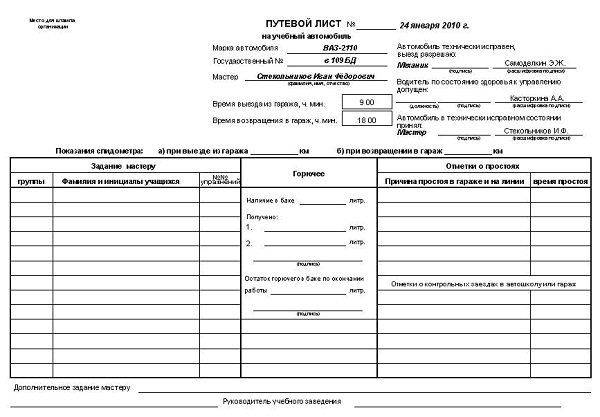
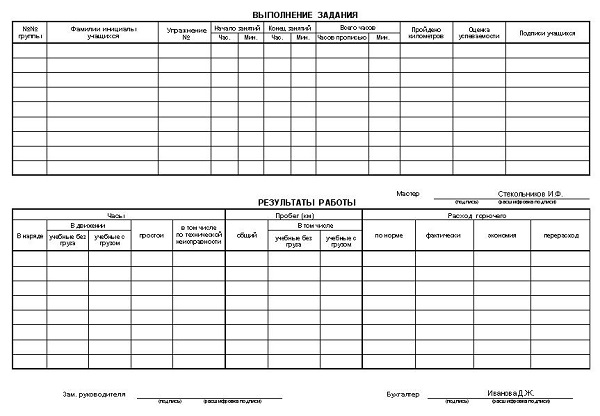
Requirements for the student, the SDA at the beginning of his studies
- The future driver must have a certificate of his admission to driving any vehicle.
- Trainees in driving a passenger vehicle must be at least 16 years old, but they will only be able to obtain rights when they come of age.
- Those who wish to study driving in categories C, D, E, etc. must already have a category B driver's license.
- The student is required to be guided by traffic rules not only in theoretical classes, but also in practice.
Riding: with whom, where and when?
A training ride on the city roads can be carried out only in the presence of an instructor and if the student has sufficient initial driving skills (without pedal mistakes, changes gears, knows how to turn, etc.). Knowledge of basic knowledge of traffic rules, as well as the ability to recognize a sign, are mandatory.
Driving in a residential area or on motorways is prohibited. Training routes must be coordinated with the traffic police, on the territory of service, which they pass.
The list of roads (in and outside localities) on which instructional riding is prohibited is approved by local authorities and published in the media. If the student does not have initial driving skills, then the first practical classes are held in a closed area on a special site, which is assigned to a driving school and with the obligatory presence of duplicate pedals in the car. A training ride in the city is possible only after a few classes on the site and the candidate assimilation of all technical rules for driving the vehicle by the candidate.
Regardless of the place of practical training, the car must have the sign “Training car”, the car has a camera and a DVR, and the instructor has a waybill. Each time the equipment is checked for serviceability.
How is the exam done?
 The exam after training in a driving school is taken in 3 stages:
The exam after training in a driving school is taken in 3 stages:
- theoretical;
- practical on site;
- practical in the city.
For the practical exam, a waybill and an examination form are required, in which marks about errors and the final result are passed: passed or not passed. The exam is taken in a car that has an identification mark and regulated equipment. In examination cars, duplicate pedals are also usually placed, because even during the examination a situation may arise that requires a professional approach.
Theoretical exam: a driver candidate is given a form in which he puts the numbers / letters of the answers that he considers correct, and a sheet with questions. No more than 2 errors are allowed. They usually prepare for a theoretical exam during the entire period of study, solving exam tickets in special publications.
Practical exam at the site (circuit): only those who pass the theoretical exam are allowed to take it. At this stage, it will already be seen how well the future driver owns the car's controls, and is also aware of the rest of the principles of driving. Training ride is carried out on the circuit with the implementation of 5 tasks: a U-turn, parallel parking, entry into the box, overpass and a snake. Requirements: no more than 5 points for errors. At this stage, the DVR and all cameras in the car are included in the exam. 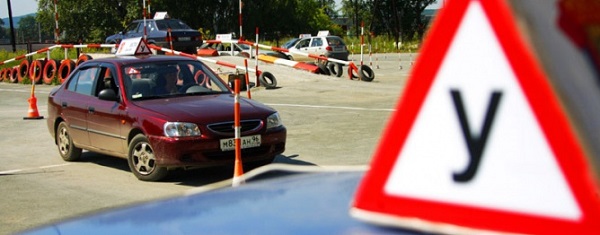
Practical exam in the city: Driving in the city is the most difficult step for most students. The examination form at this stage has a large number of columns with possible errors, the total score for which should not exceed 5, although one missed or incorrectly interpreted mark already gives 3 penalty points. Mandatory DVR, which captures all the actions of the driver both inside the car, and on the road, and the camera. Penalty points are also awarded when the instructor uses additional equipment (redundant pedals) or otherwise interferes with the vehicle control process.
The settlements in which many people live are crowded with various vehicles, so driving in the city requires dexterity and care from the driver. Since the flow of cars is quite dense, while driving, the motorist has to constantly deal with other traffic participants, including not only cars, but also pedestrians. The organization of traffic in settlements involves the use of a large number of road signs, traffic lights, junctions, therefore, before leaving on a city street, you need to thoroughly study traffic rules and the rules of travel for complex road junctions.
The first "steps" on the path of conquering urban roads
A novice driver who received “rights” as a result of training within the walls of a regular driving school, objectively speaking, has very poor driving skills on a busy road. Therefore, it is better to start the development of avenues and streets of the metropolis in the early morning, when there is still not too dense flow and impassable traffic jams. The route for the first exit to the urban jungle is better to choose a friend in order to have an idea of \u200b\u200bthe signs and intersections present on the route. When driving around the city, it is precisely the intersections that can become a serious test for the “kettle” driver, especially when it comes to crossing roads with multiple numbers of lanes. Traffic participants must, in advance, at the entrance to the junction, which is regulated by a traffic light, occupy exactly the lane from which the passage in the direction necessary for the driver is allowed. If it turned out that, by chance, the driver occupied the “wrong” lane, then there is no need to panic, let alone maneuver in violation of the rules. You can simply drive to the next intersection in order to turn around or adjust the route in the right direction.
Smoking harms not only health but also traffic safety
Unlike driving on the highway, driving in the city requires a constant and immediate response to all kinds of situations. Therefore, it is very important to be concentrated, which means that it is vital to get rid of everything that can at least somehow put the driver in control of the machine. The tobacco addiction criticized by doctors can be harmful to the motorist, because the process of lighting a cigarette or smoke that has got into the eye is very distracting for the person driving. The same thing also affects other “joys” of a modern car enthusiast, therefore it is strictly forbidden for the driver to move around the city:
talk on a cell phone without a headset;
eat, drink, view documents;
control the radio;
use a mirror on the windshield to tidy up the makeup (applies to the beautiful half of the drivers).
Need to become an organic component of the flow
When driving in the city it is very important to feel the rhythm of the surrounding traffic. You should choose a speed that would be similar to the speed of other cars moving in the same direction. This eliminates the need to overtake other cars and saves from the signals of those cars whose drivers are annoyed by your driving too slow.
In the city, fans often show off and blink their headlights to show themselves to be the “dominant male” on the road. It is necessary to learn how to ignore such signals, but only on condition that during the ride the driver does not occupy the extreme left lanes intended for movement at a higher speed. In order for the inexperienced driver to take the maneuver on multi-lane roads, it is best to occupy the middle lane.
Maneuvering in the city requires the driver to constantly use the rear-view mirror. But even a careful look in the mirror sometimes does not protect the motorist from an emergency, because there are so-called “dead” viewing areas. Therefore, it is recommended that when you rebuild to the left, in addition to looking in the mirror, you can also monitor the strip by which you are going to rebuild by turning your head. When changing lanes and turns, it is necessary to turn on turn signals in advance in order to inform other drivers about their actions.
An important tool for trouble-free movement in settlements is maintaining a safe distance from the car in front. If a scorcher tries to wedge himself into the distance meters left by the driver, one does not need to interfere with him, because in this way he can be drawn into an accident. In general, the city has the old driving principle "UDD", which stands for "give way to a fool."
Bigger city
the less people in it!
When buying a car, we, from the category of pedestrians, automatically fall into the category of drivers, while getting more comfort, and the load is also the responsibility not only for ourselves, but also for the people around us.
In traffic, people spend up to 5 years of their lives
Every day the number of cars on the road is constantly growing and today it already resembles the number of fleas on a groomed dog. At the same time, the quality of driving, if it does not fall, does not increase, leaving much to be desired. That is why driving through the streets of megacities, which today have become more reminiscent of “gigopolises,” requires the driver to have special skills related to factors such as tight traffic jams, behaviors of a certain category of impatient and irritated drivers who definitely need to be allowed to drive under the influence of sedatives, and much more.
Statistics show that the bulk of traffic accidents on the streets of large cities occur at speeds that do not exceed 60 km / h. In other words, a violation of the speed limit is, contrary to popular belief, far from the main problem of the metropolis.
The main rule of driving in a big city sounds to the ingenious simple - never, under any circumstances, do not interfere with other participants in the movement. At the same time, never forget that inexperience is far from a vice, which cannot be said about the lack of elementary respect for other drivers and the unwritten rules that apply while driving along the streets of a big city.
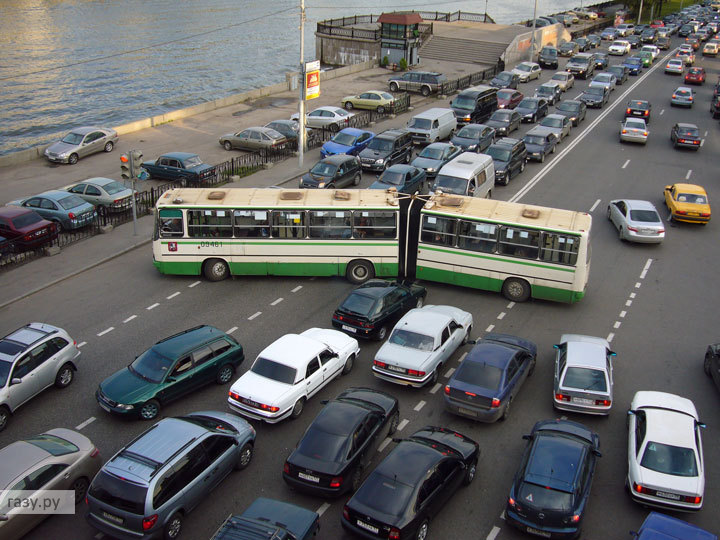
The main condition for driving in a metropolis is not to interfere with other road users
So if you can classify yourself as an inexperienced driver, in other words, “dummies”, don’t be shy - mark your car with a yellow exclamation mark indicating that the driver is behind the wheel, whose driving experience is less than two years, or sign with the letter "U".
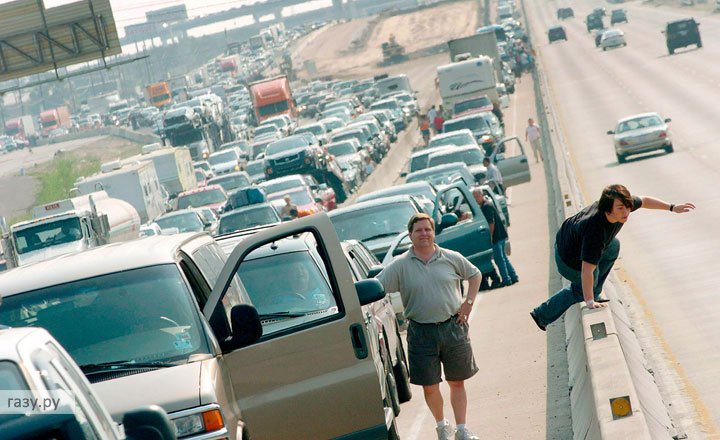
There are a lot of obstacles on the road: from a daredevil idiot ...
And let the yellow square with an exclamation mark affect many experienced drivers like a red rag on a bull (some representatives of the “bull-like” breed often resort even to physical punishment), and the letter “U” in the warning triangle is often deciphered as “killer” - you all the same, you cannot hide your own insecurity, because a warning about your inexperience will never be superfluous.
The upbringing and politeness listed in the "Red Book"
To say that all road users are polite and well-mannered is to spit in the well of truth. It’s impossible to get used to the robbers from the highway, but the time will come, and you will certainly learn to take this phenomenon more calmly. In the meantime, you should be taken for granted that you can be cut, rude into an open window, or sharply braked, creating an emergency situation.
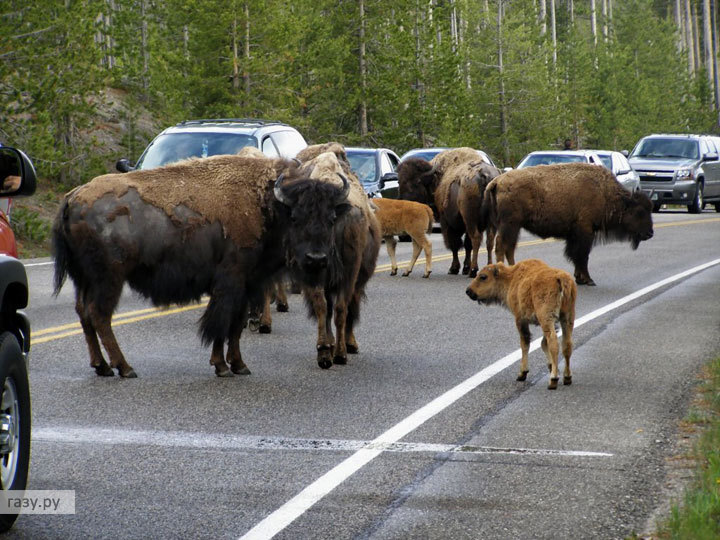
Until the bison, guided by the rule "I do not care"
And under no circumstances should you respond to rudeness with rudeness, because it doesn’t solve the problem, and you shouldn’t become like ignoramuses and fall into bad behavior if only because in this case you will not have the right to an adequate attitude of other drivers on your actions.
Gruffians who think of themselves too much can be very easily besieged by cooling their ardor, splashing it with an effective “educational-brake fluid”: lightly press the brake pedal to blink brake lights, without having to slow down. The main thing is to make sure that your prank does not cause an accident.
Another feature of driving in a big city is maintaining distance. With all this, it is very important to stay calm and adhere to the rules of the road. Feeling right, you will always be on a horse, while being in the comfortable interior of your own car. If you reduce the distance to an unacceptable minimum, you will automatically deprive yourself of the opportunity to maneuver in the event of a critical situation and reduce the reaction time, which for each driver is purely individual.
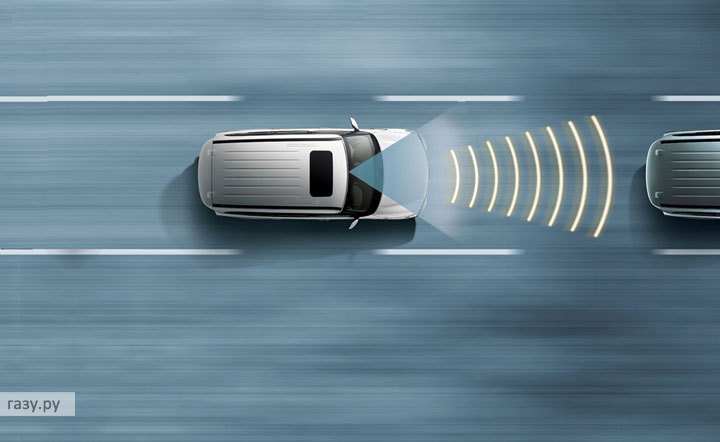
Keeping a distance helps you avoid big trouble
In traffic jams or at traffic lights, it is preferable that the distance between you and the vehicle in front is at least 2 meters. Extra centimeters will always give you the opportunity to go around a suddenly stalled car or have time to brake without kissing an adjacent trunk, if the need arises.

Sometimes it’s almost impossible to figure out the traffic clutter
The hasty rear hike, which is struggling to push you into action by emitting sound and light signals, can be reassured by simply ignoring its creeps - everyone on the road is in the same position, if not stipulated by the Rules of the road. The most valuable feature of a driver on the streets of a stone jungle is the ability to find compromises, make the right decisions and always remember that mutual respect is one of the commandments of the Scriptures of a motorist.
About women as men
When a female driver is on the road, she finds herself in a world that is completely occupied by representatives of the strong half of humanity. In other words, it should behave as the unspoken rules of the road require. At the same time, one should not think at all that driving a vehicle is at least somewhat inferior to men.

Women have a long driving experience
All the same lean old woman statistics indicate that women are more circumspect on the roads and become participants in accidents much less often than men prancing on their "trotters". However, the stereotype that a woman driver is like a monkey with a grenade is ineradicable - the bulk of men are still confident that a woman on the road can automatically be regarded as a potential danger.

Car mirrors should be used as intended.
We do not have any special recommendations for women, but for the time of riding it is worth forgetting that mirrors can be used for something else, except for controlling the traffic situation. Makeup will wait, men will not stop kissing you even inaccurate cosmetics, but the road will not forgive you even the slightest mistake.
Road traffic forecast
Often, novice drivers do not notice anything on the road except the car in front. But in order to make the ride as safe as possible, you must be able to control the situation on the road so that you can react to its change at any time.
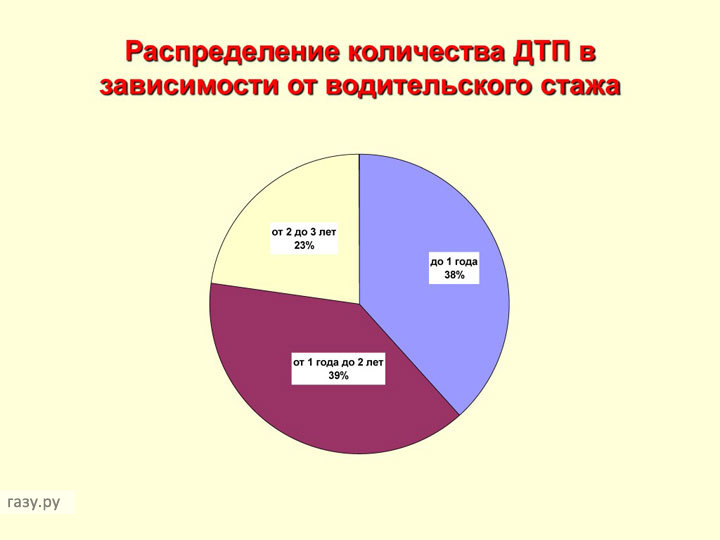
New drivers - a potential threat on the road
Look in the mirrors as often as possible - at first it will distract you from driving, but then it will become a habit and become your trump card against possible changes in the situation on the road.
Be sure to control “” and ask yourself the question “What if? ..” This will help you correctly assess the opportunities and intentions of other road users.
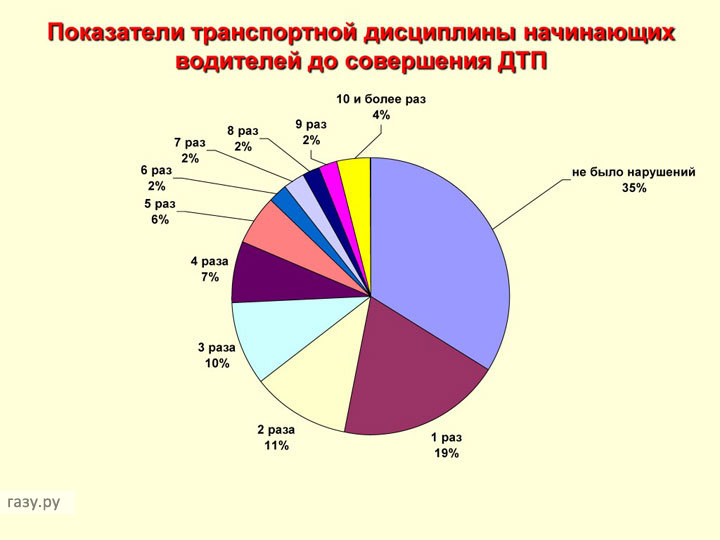
The number of violations before the accident
Good luck on the road! No fluff, no feather, no wand, no potholes!
After many hours of studying the theory, driving with an instructor and advice from friends and relatives, you come to MREO. Until the theory exam is passed, you will not be allowed to drive. But if you were able to answer the questions about the rules correctly, then your driving skill will be checked in practice by an inspector, first on the site with an artificially created obstacle course, and then, and this is the most difficult, in urban conditions. Many disappointing failures happened at this stage. Let's figure out how to avoid failure while driving around the city.
What is being checked
It would seem that the site should be enough. Snake, overpass, parking - what else is needed to evaluate your skill? In fact, of course, everything is not so simple. The fact that you can pass the theoretical exam and turn the steering wheel on refined obstacles does not mean that you will drive confidently and safely along city roads clogged with cars. Of course, this will not happen even after passing city driving if your instructor from a driving school is negligent in his work, and the exam is designed to test your skill, and not to teach. Confidence will come with experience, but after a driving school you should know what is required of you in practice, be able to read signs and follow. It doesn’t matter how good you were at school, your car will still be equipped with a “student” sticker, because other drivers must be very careful on the road near you.
Of course, we do not mean that you can study through the sleeves. Our “no difference” concerns other participants in the movement, not you. For you, after a driving school, it should just be obvious that the road does not forgive mistakes. When driving a vehicle weighing more than a ton, you should never lose concentration and always need to know exactly what you are doing.

In fact, the area of \u200b\u200bchecking city driving is the hardest part of a law exam. Passing city driving is like passing an exam in an exam. Although the inspector takes the exam on a machine equipped with an additional set of pedals, he cannot prevent some situations on the road, only you can do this. Moreover, he will not only evaluate your ability to drive a car, because you have already shown it on the site, how much to assess the situation and make the right decisions. This is what is required for everyday driving around the city, if you think about it. Other drivers expect you to follow the rules, because then and only then they will know what to expect from you; the converse is also true. The key to confidence on the road is to be able to predict the traffic situation at least one step forward.
What is good and what is bad
From the foregoing, a very simple conclusion follows: do not surprise the inspector. And to achieve this is quite simple. Without exceeding the speed limits, carefully look at the road, look at the signs. Do not try to start too quickly after stops, overtake and squeeze into another row. All this will not make a favorable impression on the examiner, and even for you it will not be a positive experience. Other participants in the movement, we repeat, should understand what to expect from you. Do not forget to signal to them about what maneuver you are going to execute in the near future. We mean, of course, the turn signals, something that even experienced drivers are unfortunately sadly using. We don’t know why they are afraid of them, but we assure that there is nothing wrong with the turn signals and that when driving around the city they are extremely useful and simply necessary. Surrendering city driving, paradoxically as it may seem, is impossible without their use.
So that the driver can correctly assess the traffic situation, he needs information. He can get it with. Therefore, sitting in the car and fastened, adjust the mirrors. This may seem like a trifle, but without seeing the car, you can provoke an accident by rebuilding it. The exam certainly will not be counted. Well, turn indicators are not the only optical device needed when driving around the city. You need to turn on the side lights so that other drivers can evaluate your size and distance to your car.
Conclusion
The algorithm is simple. You get in the car in the driver's seat, buckle up. You should adjust the mirrors so that you can accurately see, without tilting your head, what is happening on the sides and behind your car. After that, turning on the "neutral",. Do not forget to turn on the side lights, otherwise your exam will end sooner than you expect. After making sure that everything is in order, engage first gear, the indicator, remove from the parking brake and move off. Of course, you should not have obstacles to movement. And then - as it is written in the rules. Without exceeding speed, go where the inspector says. That, in fact, is all.
The best prices and conditions for the purchase of new cars
Credit 4.5% / Installments / Trade-in / 95% approvals / Gifts in the salonMas Motors


